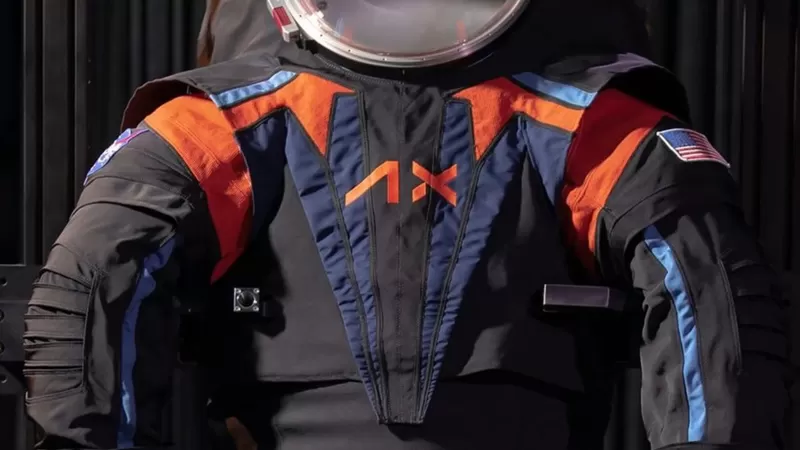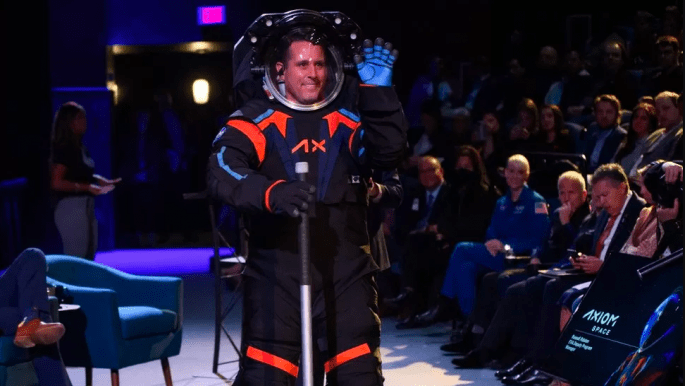?What would it take to make a spacesuit fit for standing on the moon again

Later this decade, humans will be standing on the moon again. The suits they wear will be far more advanced than those worn by the Apollo astronauts.
In 2025, NASA is scheduled to return humans to the moon through its new Artemis 3 mission, and billions of eyes will focus on what the two astronauts will wear to reach the moon again. Although astronauts jump on the surface of the moon instead of walking.
The geeks among us have already caught a glimpse of the apparel in store at NASA's Houston Center in Texas. There, a new spacesuit prototype for a new era of lunar travel emerges.
?What was on offer
It featured a single spacesuit, in sleek black with flashes of orange and blue. Although multiple suits appeared on the rack, they were all classic white, like those used on the Apollo missions more than 50 years ago.

Unlike Apollo, these lunar spacesuits will also have a new designer designation: Axiom Space. Founded in 2016, this spaceflight supplies company has already carried out its first astronaut mission and is also planning to build its first commercial space station.
"It definitely felt like we were like the new kids on the block," says Mark Greeley, EVA program manager at Axiom, who has managed the spacesuit project and launched entry-level production projects for NASA throughout his career. "But a lot of us, maybe 90 percent of the team, have worked at EVA in one way or another throughout their careers."
Like Greeley, many of Axiom Space's employees have previously worked at NASA, with a leadership team that includes Charlie Bolden, a former NASA astronaut and administrator, who works as a business development consultant.
A defective battery in a Russian cosmonaut's suit ends his spacewalk
?What do astronauts eat outside Earth, and how
NASA expects humans to live on the moon within this decade
There was also a touch of star quality in the Axiom prototype suit from the films' spacesuit designer Esther Marcus.
Esther Marcus, lead costume designer for Shang-Chi and The Legend of the Ten Rings , and costume designer for the Apple TV+ space drama series.
“With any design challenge, there is a level of involvement and commitment that I take to achieve the desired goal, and I was keen to implement the ideas I got from my experience,” says Esther.
And there was a good reason why the outer layer of the prototype suit was black.
"My job was to design a cover layer to hide the suit's design during the spacesuit reveal event in March," adds Esther Marcus. "I'm very familiar with the historic spacesuits I used for our show. I wanted to pay tribute to that legacy and celebrate space exploration. It was an opportunity." Great to meet and talk about spacesuit design with a company that actually sends humans into space (not in the movies) and was thrilled to discover that Axiom spacesuit engineers are truly artists, creatively solving complex problems."

New spacesuits for the lunar surface will not be as bulky as those currently used for spacewalks
Manual and machine sewing often plays an important role in the space industry, whether it's on spacesuits, the fabric between the seams of the space shuttle, or on the heat shields for the BepiColombo mission to Mercury.
Greeley agrees: "It takes a lot of experienced seamstresses, or textile technicians, to do this kind of work, and they really are artists."
First and foremost, of course, the new lunar spacesuits are important elements for ensuring the life of (astronauts), air supply and protection from radiation and micrometeorites. Despite the desire to return to the historical legacy, there is always room for improvement.
"Apollo's zips, metal cables, and rubber in suits used 1960s technology and were great for a single mission, but that's no longer the case," says Bill Airy, author of Lunar Clothing: The Making of the Apollo Spacesuit.
He added, "The biggest developments came immediately after Apollo when the space shuttle suit was designed, designed with many components that could be interchanged to accommodate the largest number of crew members."
A new asteroid will approach Earth on Valentine's Day 2046
?What do astronauts eat outside Earth, and how
Airey previously worked as a space suit test engineer and historian at ILC Dover, the company that made the Apollo suits and those used by astronauts today on spacewalks from the International Space Station.
Many of the materials in spacesuits for both environments still have their origins in the 1950s and 1960s and include spandex in the warm suit layer to provide liquid cooling, Mylar (polyethylene terephthalate) for insulation, Kevlar, which is used in bulletproof vests, and a layer Flame retardant Nomex, worn by racing drivers, as well as urethane-coated nylon, which can have welded seams and is commonly used to adjust the internal airtight pressure of a suit.
Today's modern suits, Airy explains, use advanced composites and other materials to provide structural strength, allow for sizing adjustments, and provide greater comfort while providing longer component life.
Determination of body size is important. In 2019, NASA had to postpone the first women-only spacewalk because the International Space Station did not have enough spacesuits of the right size.
However, since NASA had already begun work on the new suit before it was brought into production, Axiom did not have to start the process of manufacturing its suit from scratch.
“There are a few components, such as the rigid upper torso and the helmet bubble, that were very advanced in design but we've completely redesigned the compression garment system,” says Greeley. “We've also significantly reduced mass (the suit) by 20 lbs (9 kg) so far.” - And we increased the movement.

More than 50 years will separate the suits worn by lunar explorers in the Apollo program and the Artemis astronauts.
The helmet angle of the Axiom suit no longer resembles the traditional inverted goldfish bowl helmet it did on Apollo, as it is distinguished by an extended over-the-horizon vision rate.
"For lunar spacesuits, the astronauts look down most of the time."
The gravity on the Moon is one-sixth that of the Earth, and this affects the design.
"Lunar spacesuits have to be lightweight because they're used in a gravitational environment," Airy says, "and planetary and lunar suits have to provide excellent torso mobility since you're walking in a gravitational environment and not just floating."

Former NASA astronaut Peggy Whitson called the suit prototype "a great example of what innovation can do. This would be a much more flexible suit."
It is assumed that Peggy Whitson realizes the importance of this, given that she currently holds the world record for the longest cumulative time in space (665 days), and as head of human spaceflight in Axiom, she is scheduled to increase this record on May 8, as she will be the leader Flight Ax-2, the company's second special mission to the International Space Station. Several astronauts, including Whitson, also participated in the new suit experience.
?Artemis: Why did NASA choose to name its mission after the goddess-hunter
?Why was the JOS space probe's mission to explore life on Jupiter's moons postponed
"I think the most common comment from astronauts is to keep it simple," Greeley says.
As for the gloves, they're meant to make sure astronauts "do basic skills and keep their hands warm or cool, depending on the environment. After working on multiple programs, I'd say our gloves are probably the best I've seen."
The temperatures on the Moon are extreme, unlike on Earth. The lunar cycle is about 14 bright days and 14 dark days.
During the dark, temperatures can drop to -253°C, and reach as high as 120°C in the sunlight.
The Apollo astronauts needed that solar energy, and so did the Artemis crew, and their suits were white to reflect heat and prevent body temperatures from dangerously high.
During the Apollo missions, ultrafine moon dust got into astronauts' instruments, causing overheating of cooling grilles and damage to spacesuits.

"It will be critical to ensure that lunar dust cannot penetrate the inner layers, metal bearings and other components," Ayre explains.
Once complete, the new lunar spacesuit must undergo testing in a space-like environment.
A NASA spokesperson explained what was required and said, "An analog demonstration could consist of an underwater demonstration experience using weight loss, via a thermal vacuum chamber or other NASA-approved methods."
The final test will, of course, be on the Moon itself. Failure is definitely not an option.
Source : websites

